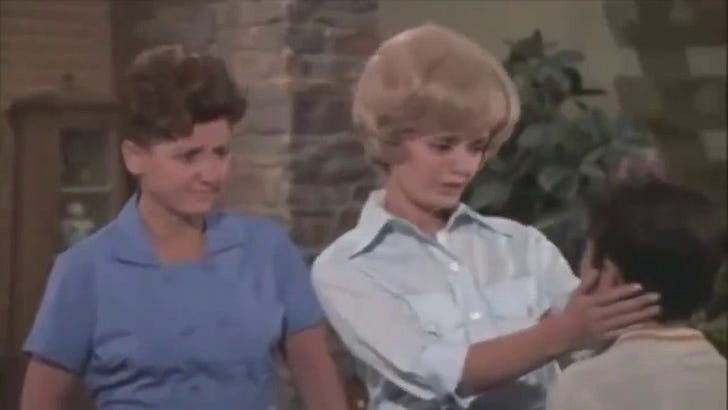The Manufactured Fear of Measles: From Brady Bunch Banter to Public Health Panic
In a now-infamous episode of The Brady Bunch, aired in 1969, the family reacts to a case of measles with light-hearted humor. "If you have to get sick," Marcia quips, "sure can't beat the measles." The children enjoy a brief vacation from school, and no one seems particularly concerned. This casual treatment of the illness on a prime-time family show reflected a broader societal attitude at the time: measles, though contagious, had become a routine childhood illness—not a cause for panic.
How did we go from a sitcom chuckle to a full-blown public health campaign warning of near-apocalyptic consequences for the unvaccinated? The shift wasn’t organic. It was a top-down messaging campaign that gradually rewrote public perception—starting around the mid-1990s and accelerating sharply in the early 2000s. The transformation of measles from mundane to monstrous wasn’t about science evolving; it was about narratives being manufactured.
The Real Historical Risk of Measles
Before we dive into the fear campaign, it's worth noting: measles was once a dangerous disease. In the late 1800s and early 1900s, prior to the development of modern sanitation, nutrition, and supportive care, measles could and did cause significant mortality—especially in crowded, impoverished communities. But by the 1950s and early 1960s, long before the introduction of the measles vaccine in 1963, the mortality rate had already plummeted by over 95% in developed nations like the U.S.
Improved housing, better nutrition, clean water, and access to medical care—these were the real public health game-changers. When the vaccine was introduced, it was not to stop a deadly epidemic, but to reduce the inconvenience of illness and to eliminate the virus altogether.
Enter the Vaccine—and the Narrative Shift
Initially, the measles vaccine was promoted as a convenience, not a necessity. Even the CDC in early literature characterized measles as a "self-limiting" disease in healthy children. The vaccine was welcomed, but not seen as life-saving. Uptake was good—but not universal—and crucially, no one panicked when cases still popped up.
That changed in the 1990s. As the U.S. neared measles "elimination" status in 2000 (meaning no continuous transmission), public health messaging began to subtly shift. With fewer and fewer cases, authorities had to justify continued mass vaccination. The new argument? Even one case is too many. This marked the beginning of what critics might call a "zero tolerance" propaganda campaign.
Fear Ramps Up: 2000s to Present
In the early 2000s, media coverage of measles took a darker turn. Isolated outbreaks—often involving mild cases—were now described as “public health emergencies.” Words like epidemic, dangerous, and life-threatening were reintroduced into the public lexicon. News reports were often punctuated with alarming imagery: coughing children, hospital beds, and stern-faced doctors warning of catastrophe.
The CDC and WHO began emphasizing extreme-case outcomes (encephalitis, death), even though such complications remained exceedingly rare in developed nations with adequate healthcare systems. Suddenly, the exception became the rule, and anyone questioning the urgency of mass vaccination was painted as a public menace.
The 2015 Disneyland outbreak became a pivotal moment. Though no deaths occurred and most cases were mild, the media and public health agencies went into overdrive. Politicians called for stricter mandates, and laws were passed eliminating philosophical and religious exemptions to vaccination in several states. The Brady Bunch episode? Memory-holed. It didn’t fit the new script.
Propaganda or Public Health?
Let’s stop pretending this is still a debate about public health. The evidence is overwhelming: vaccines—MMR included—are not the harmless, sacrosanct miracles they’ve been sold as. They carry real risks, many of which are buried under mountains of bureaucratic denial and media spin. While measles itself is rarely fatal in the modern world, the MMR shot has been tied to severe adverse effects, including death—and that’s just what we know from a chronically underreported system like VAERS. The math doesn’t lie: we’re risking more lives by injecting millions of kids than we’d ever save from measles in today's environment. So why the panic? Because fear is profitable. Fear justifies mandates, sells pharmaceuticals, and silences dissent. The campaign to make measles terrifying again wasn’t about saving lives—it was about controlling the narrative. If the public ever realized they’ve been duped, not just about measles, but about the entire vaccine paradigm, the credibility of the medical establishment would collapse like a house of cards. And maybe that’s exactly what needs to happen.



Thanks, well worth exposing the fraud.
Re 'measles was once a dangerous disease'. This is misleading as measles iscurrently defined by symptoms rather than cause. The danger lies in the conidtions causing the dis-ease which were as much as anything overcrowding, poor sanitation, poor nutrition and poor drinking water supply.